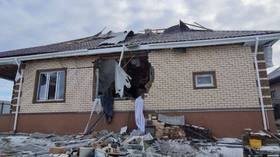The perfect storm sends natural gas crashing
With inventories set to reach levels never seen before and a serious drop in demand in Asia, natural gas prices could be set to fall even further.
If you’re waiting for natural gas prices to recover, you might be in for a considerable wait, as inventories are expected to hover well above their five year average for the remainder of the year, the EIA has forecast, painting a rather sour picture for the industry that has seen investments stifled due to the lower prices.
In fact, inventories later this year will reach levels never seen before if forecasts prove accurate.
Also on rt.com Shale decline inevitable as oil prices crashThe Nitty Gritty of Nat Gas Supply and Demand
According to the Energy Information Administration Short-Term Energy Outlook (STEO), working natural gas in storage in the Lower 48 will end the current heating season—which ends on March 31—at 1,935 billion cubic feet.
This is 12% above the previous five-year average.
Now, we’re about to head into what the industry refers to as “the refill season”. Normally, the end of the heating season is when inventories are at their lowest. Now, we’re heading into this stockpiling season with inventories that are high. So we will be amassing even more nat gas in inventory as heating demand falls off.
The EIA estimates that we will end the refill season, which runs until the end of October, with 4,029 billion cubic feet. This would be the largest monthly level of nat gas we’ve ever had in storage.
At the end of January, inventories had already reached 2.6 trillion cubic feet.
COVID-19 and the Weather
The COVID-19 outbreak—likely soon to be pandemic—might be the obvious target on which to lay blame for the increasing inventories. After all, it is responsible for demand in crude oil.
But that is only a piece of the puzzle, with weather, weather, weather topping the list of critical factors that are affecting natural gas inventories.
January 2020 was the fifth warmest January on record—that’s out of over 125 years of data. January 2020 saw average temperatures of 35.5 degrees F across the United States. This is 5.4 degrees more than the 20th Century average, according to the US Department of Commerce’s National Oceanic and Atmospheric Administration.
The problem? It’s just been so warm that the need for heating has been reduced, depressing demand. And while production has not fallen with demand, inventories have bloomed. Add to that unfavorable price scenario the fact that COVID-19 is spooking the market and further denting demand, and you have a perfect storm for lower nat gas prices.
Oftentimes, these lower price points created by subdued demand in one sector courtesy of the mild weather will create additional demand from other segments. Large-volume users such as power plans or iron and steel mills have the ability to switch between nat gas and coal or even petroleum—and they will choose the lowest cost ones. So as natural gas in storage climbs and prices fall, one would expect a bit of an uptick in demand from some of the other sectors.
But it has done little to mediate inventories.
While weather has been the primary driver of the lower nat gas prices, COVID-19 is worth a mention. The virus is expected to strip away 10bn m3 from China’s 2020 gas demand alone, according to Sublime China Information. Most of this demand destruction will be seen in Q1. For China, some are expecting gas demand to return to normal by March, if things don’t get worse—a condition that public health officials are saying is likely to happen.
Also on rt.com 'Gasmaggedon' sweeps over global gas marketProduction Won’t Fall Off Enough
Natural gas production has shown no signs of slowing throughout 2019. In fact, in 2019, US natural gas production was at record levels, averaging 92.1 billion cubic feet per day. And 2020 isn’t looking any better.
Towards the end of 2019, average production was higher than at the beginning of 2019, so while the EIA sees monthly production declining in 2020, from 95.4 Bcf/d last month to 92.5 Bcf/d in December, the average for 2020 is still expected to be 2% higher than the average of 2019.
Inventories Up, Prices Down
This weather phenomenon combined with robust production is tanking the price of natural gas. The Henry Hub spot price averaged $2.02 MMBtu. But after the first week of February, prices had fallen to $1.86 MMBtu. Even through the remainder of the heating season, when inventories typically contract, the EIA expects nat gas prices will stay below $2 MMBtu. Prices should tick up in Q2, the EIA says, with an overall average price of $2.53 MMBtu for the year.
Whether its weather or COVID-19, record inventories for nat gas are likely on their way. And with record inventories comes low prices—a fact that offers traders about as much certainty as they’re going to get in this volatile market.
This article was originally published on Oilprice.com















